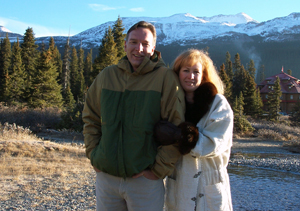"Why did you do it?"
That's a question Sandi Hurcomb gets asked often, when she talks about donating a portion of her liver to a stranger.
 For Sandi, the decision was immediate and easy. After hearing a radio story about a father of four children who desperately needed a new liver to save his life, she knew instantly that she could do something to make his situation better.
For Sandi, the decision was immediate and easy. After hearing a radio story about a father of four children who desperately needed a new liver to save his life, she knew instantly that she could do something to make his situation better.
Sandi tried to find the father, but could not. Instead she found the Living liver Donor Program at TGH, and filled out an online application form. When she was called in to meet the team in Toronto, she sat in the waiting room, noticing that doctors who were passing by always stopped to chat with patients, remembering each patient’s name.
When the transplant team asked her why she wanted to donate to a stranger, Sandi thought she could just as easily make a donation to someone else who needed an organ as much as to the father whose plight had touched her so deeply.
“It’s just as natural for me to say, why wouldn’t I?” says the upbeat, 44-year-old special needs educational assistant from Manitoulin Island. She thinks for a moment, then adds, “This is one definite thing that I can point to and say I did right in my life. There could be no question that what I did was good and a fully conscious choice.”
After making up to 14 trips to Toronto to get tested, two postponed surgeries due to the recipient becoming ill and a clotting complication for Sandi, she became a living donor on June 21, 2010.
In a living donor liver transplant, a surgeon removes up to 70% of an adult donor’s liver, with the liver growing to its full size in about six weeks. Sandi was able to leave the hospital after seven days, and had fully recovered after three months.
“I am an altered Sandi,” she muses. “I have become introspective, and I see things anew, through the eyes of a recipient who I deeply hope has a new start at life. I will have given life without having given birth.”
In Ontario, a shortage of organs from deceased donors has contributed to the growth of TGH’s living liver and kidney donor programs. As of two years ago, about 17% of Ontarians had registered to be donors, compared to 30% of people in the U.K. and 37% in the U.S. And Toronto has the lowest rate in Ontario, with an average of 12% of people registering to be a donor; Sudbury, for example, has 34% of its residents registering.
TGH has the largest program for living liver donors in North America, performing between 75 and 100 living donor adult and pediatric liver transplants a year. Despite this, about one out of every three patients on the wait list dies before getting a liver transplant.
One quarter of all Canadians who are waiting for a kidney live in Ontario—more than 1,000 at any point in time. In Toronto, patients can expect to wait an average of about six years. TGH reduces that wait time, by performing more than 60 living donor kidney transplants per year, about the same number as deceased donor kidney transplants.
“Our living donor programs are among the best in the world in terms of volume and outcomes,” says Dr. Gary Levy, Medical Director of the Multi Organ Transplant Program. “We admire the courage of these donors, but we must remember that we ask this of healthy, living donors because we don’t have enough deceased donor organs.”
The UHN Organ Donation Committee has also been working extremely hard to increase our rates of organ donation by reviewing our processes, improving data quality and engaging front line staff.
Over the past year and a half, organ and tissue donations have been steadily increasing at UHN. As a result of our committed and compassionate staff, in corporation with Trillium Gift of Life Network (TGLN), our conversion rate (the number of deceased organ donors among all potential organ donors who die in hospital) was 83% as of the third quarter. The UHN benchmark is 57%.
Organ donation from one individual can help up to eight others. Tissue donation from one individual can help up to 75 others. Find out more about registering to become a donor at
beadonor.ca.
